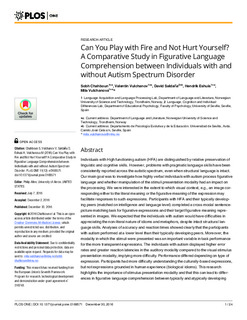| dc.contributor.author | Chahboun, Sobh | |
| dc.contributor.author | Vulchanov, Valentin | |
| dc.contributor.author | Saldaña, David | |
| dc.contributor.author | Eshuis, Rik | |
| dc.contributor.author | Vulchanova, Mila Dimitrova | |
| dc.date.accessioned | 2017-03-13T12:04:26Z | |
| dc.date.available | 2017-03-13T12:04:26Z | |
| dc.date.created | 2017-01-02T16:14:56Z | |
| dc.date.issued | 2016 | |
| dc.identifier.issn | 1932-6203 | |
| dc.identifier.uri | http://hdl.handle.net/11250/2433951 | |
| dc.description.abstract | Individuals with High functioning autism (HFA) are distinguished by relative preservation of linguistic and cognitive skills. However, problems with pragmatic language skills have been consistently reported across the autistic spectrum, even when structural language is intact. Our main goal was to investigate how highly verbal individuals with autism process figurative language and whether manipulation of the stimuli presentation modality had an impact on the processing. We were interested in the extent to which visual context, e.g., an image corresponding either to the literal meaning or the figurative meaning of the expression may facilitate responses to such expressions. Participants with HFA and their typically developing peers (matched on intelligence and language level) completed a cross-modal sentence-picture matching task for figurative expressions and their target figurative meaning represented in images. We expected that the individuals with autism would have difficulties in appreciating the non-literal nature of idioms and metaphors, despite intact structural language skills. Analyses of accuracy and reaction times showed clearly that the participants with autism performed at a lower level than their typically developing peers. Moreover, the modality in which the stimuli were presented was an important variable in task performance for the more transparent expressions. The individuals with autism displayed higher error rates and greater reaction latencies in the auditory modality compared to the visual stimulus presentation modality, implying more difficulty. Performance differed depending on type of expression. Participants had more difficulty understanding the culturally-based expressions, but not expressions grounded in human experience (biological idioms). This research highlights the importance of stimulus presentation modality and that this can lead to differences in figurative language comprehension between typically and atypically developing individuals. The current study also contributes to current debates on the role of structural language in figurative language comprehension in autism. | nb_NO |
| dc.language.iso | eng | nb_NO |
| dc.publisher | Public Library of Science | nb_NO |
| dc.rights | Navngivelse 4.0 Internasjonal | * |
| dc.rights.uri | http://creativecommons.org/licenses/by/4.0/deed.no | * |
| dc.title | Can you play with fire and not hurt yourself? A Comparative study in figurative language comprehension between individuals with and without Autism Spectrum Disorder | nb_NO |
| dc.type | Journal article | nb_NO |
| dc.type | Peer reviewed | nb_NO |
| dc.source.volume | 11 | nb_NO |
| dc.source.journal | PLoS ONE | nb_NO |
| dc.source.issue | 12 | nb_NO |
| dc.identifier.doi | 10.1371/journal.pone.0168571 | |
| dc.identifier.cristin | 1419481 | |
| dc.description.localcode | ©2016Chahboun et al. This is an openaccessarticledistributedunderthe termsof theCreativeCommonsAttributionLicense,whichpermitsunrestricted use, distribution, andreproductionin any medium,providedthe originalauthorand sourceare credited. | nb_NO |
| cristin.unitcode | 194,62,60,0 | |
| cristin.unitname | Institutt for språk og litteratur | |
| cristin.ispublished | true | |
| cristin.fulltext | original | |
| cristin.qualitycode | 1 | |

